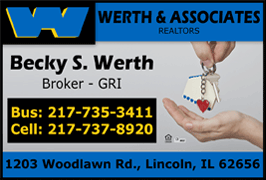Average rate on a US 30-year mortgage rises to 6.86%, its highest level
since mid-February
[May 23, 2025] By
ALEX VEIGA
The average rate on a 30-year mortgage in the U.S. climbed this week to
its highest level since mid-February, a setback for home shoppers that
threatens to slow sales further this spring homebuying season.
The rate increased to 6.86% from 6.81% last week, mortgage buyer Freddie
Mac said Thursday. A year ago, the rate averaged 6.94%.
Borrowing costs on 15-year fixed-rate mortgages, popular with homeowners
refinancing their home loans, also rose. The average rate ticked up to
6.01% from 5.92% last week. It’s down from 6.24% a year ago, Freddie Mac
said.
Mortgage rates are influenced by several factors, including global
demand for U.S. Treasurys, the Federal Reserve’s interest rate policy
decisions and bond market investors’ expectations about the economy and
inflation.
The average rate on a 30-year mortgage has remained relatively close to
its high so far this year of just above 7%, which it set in mid-January.
The average rate’s low point so far was five weeks ago, when it briefly
dropped to 6.62%. It’s now at its highest level since Feb. 13, when it
averaged 6.87%.

The elevated mortgage rates, which can add hundreds of dollars a month
in costs for borrowers, have discouraged home shoppers, leading to a
lackluster start to the spring homebuying season, even as the inventory
of homes on the market is up sharply from last year. Sales of previously
occupied U.S. homes fell last month to the slowest pace for the month of
April going back to 2009.
The recent rise in mortgage rates reflects moves in the 10-year Treasury
yield, which lenders use as a guide to pricing home loans.
The yield, which had mostly fallen after climbing to around 4.8% in
mid-January, began rising March amid investor anxiety over the Trump
administration's trade war. It rose again last week after the U.S. and
China agreed to a 90-day truce in their trade dispute, raising
expectations that the Federal Reserve won’t have to cut interest rates
as deeply as expected this year in order to shield the economy from the
damage of tariffs.
[to top of second column] |

A sign announces the sale of a new home, Jan. 16, 2024, in Kennesaw,
Ga. (AP Photo/Mike Stewart, File)
 This week, long-term bond yields
surged again after Moody’s lowered its credit rating for the U.S.
over concerns about swelling federal government debt.
The 10-year Treasury yield was at 4.56% in midday trading Thursday
after the House of Representatives approved a bill that would cut
taxes and could add trillions of dollars to the U.S. debt.
“Since mortgage rates closely track the 10-year yield, this upward
pressure has translated into increased borrowing costs for
homebuyers, which means higher mortgage rates,” said Jiayi Xu, an
economist at Realtor.com.
The increase in mortgage rates is discouraging some would-be
homebuyers during what’s traditionally the busiest period of the
year for home sales. Last week, mortgage applications fell 5.1% from
a week earlier as home loan borrowing costs increased, according to
the Mortgage Bankers Association.
Applications for a loan to buy a home were still up 13% from a year
earlier.
Economists expect mortgage rates to remain volatile in coming
months, with forecasts calling for the average rate on a 30-year
mortgage to remain between 6% and 7% this year.
All contents © copyright 2025 Associated Press. All rights reserved
 |